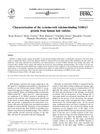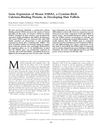Specific Citrullination Causes Assembly of a Globular S100A3 Homotetramer
December 2007
in “
Journal of biological chemistry/The Journal of biological chemistry
”
TLDR A specific chemical change in the S100A3 protein leads to the formation of a four-part structure important for hair formation.
The study investigated the role of citrullination in the assembly of the S100A3 protein into a homotetramer, particularly focusing on its Ca2+-binding properties. It was found that more than half of the arginine residues in native S100A3 were converted to citrullines by Ca2+-dependent peptidylarginine deiminases (PADs), specifically PAD3. This conversion, particularly at Arg-51, promoted the assembly of S100A3 into a homotetramer, enhancing its Ca2+-binding properties. The findings suggested that the high concentration of S100A3 homotetramer might provide the necessary millimolar levels of Ca2+ required for forming the hair cuticular barrier. The study highlighted the need for further research to understand the precise functional role of S100A3 tetramers in epithelial Ca2+-cycling systems.




